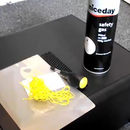Introduction: Introduction to Hardware: Learn the Basics
You don't need anything except a computer for this tutorial. Enjoy :)
Step 1: The Motherboard
Your motherboard is the central nervous system of your computer. All the veins between components hook into it. Without your motherboard, you'd have a case of rattling components with no way of communicating. The motherboard is even more important than the CPU, because your CPU wouldn't even be able to turn on without a motherboard.
There are several sizes of motherboard. The two commonly used in desktop pcs are ATX and MicroATX. MicroATX is compatible with ATX, but not vice versa.
The CPU creates another variation in mobos (short for motherboard). All manufacturers of CPU use several standards of sockets each. None of these standards are compatible with motherboards not designed for that CPU.
Motherboards have PCI slots usually, which allow for expansions such as graphic cards, network cards and firewire cards. My computer, and many others have 4 of these slots.
Step 2: CPU and Cooling
Your CPU (Central processing unit, or processor) is the brain of the computer. Without it, you computer would not respond to anything, nor would it be able to process data. This is vital to the system as it causes all functionality.
Above your CPU is a cooling fan. As the hottest component in your system, the CPU has two defenses to protect it from overheating. Firstly, there is a paste on top of your processor called the thermal compound. This is also referred to as thermal putty and thermal paste. It's job is to dissipate heat before the fan creates hot air with the heat.
On top of your thermal paste, there is a cooling fan which basically blows away the heat as hot air. Not much to explain there...
Your computer may have more fans, aside from the CPU. All will have one in the PSU, and many have fans around the system. These are case fans, which just help cool all the components and take any lingering hot air from the CPU cooler away.
Step 3: RAM
Ram is a mission critical component. Whatever you do on a computer stays running even while it isn't saved. This is down to the RAM. The RAM stores all the information you can see, window sizes, buttons, your cursor, mouse movements etc. RAM only stores this temporarily, and if any information is left on it, it will be cleared when your system turns off.
RAM comes in sticks/cards (pictured). Each year, the average amount of RAM computers have grows, because the amount programs need grows as they advance.
Step 4: Drives
There are 3 types of internal drives on the modern market: Hard Drive (HDD), Solid State Drive (SSD) and optical drive.
Most computers have either a HDD and Optical Drive or SSD, HDD and Optical Drive.
Optical Drives
These are devices that read CD, DVD, Blu-Ray, and any other disk you can think of. Almost all systems have them, because they are so commonly used. You probably know about CDs etc, so I need not explain them.
Hard Drives
The hard drive is the predecessor of SSD, but is still much more available and used than SSDs.They are permanent storage, and can be powered down while still keeping information on them, unlike RAM. HDDs are made from metal disks, and function similarly to digital cassettes. Information is encoded, then written on to the platters using magnets. The platters are then read using a stylus a lot like the ones used on vinyl record players. Because information is stored all around the disk, HDDs spin around, and platters are very fragile
Solid State Drives
A very new enhancement. They function with 0 moving parts, and are a lot less fragile than hard drives. Information is stored in a similar formation to hard drives, but instead, SSDs have negative charged electrons and positive charged electrons. It's the same technology as usb drives, flash memory. It's a complex subject, worthy of it's own instructable. For now, I recommend http://www.howstuffworks.com/flash-memory.htm as a good source of information.
Sizes
As technology advances, physical size decreases, and information capacity increases. The physical size for a hard drive in a desktop computer used usually now is 3.5". Laptops use a smaller size, 2.5". Most hard drives in mid range prebuilt computers now are 500GB, but vary all the way up to 2x1TB. Anything past that is usually a gaming computer, workstation or homebuilt
Step 5: Thanks!
A HUGE thanks to everyone who read this, including you. This is my first instructuable. I'd be appreciative of any comments, and please do comment, rate and subscribe on my youtube channel.
The next tutorial will be maintaining and cleaning your computer. Keep an eye on my profile for updates
Thanks!











